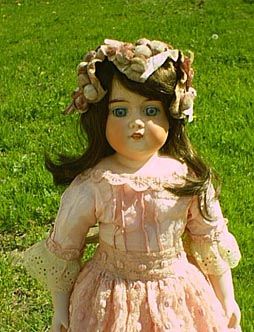Anita Jo Intenzo
Author, ESTATE OF HORROR and DARK TRANSFERENCE
Entrepreneur, PAST IMAGES BY ANITA
Author, ESTATE OF HORROR and DARK TRANSFERENCE
Entrepreneur, PAST IMAGES BY ANITA
Main Navigation
German Dolly-Faced Dolls
 The German "dolly-faced" child dolls are the ubiquitous antique bisque dolls that collectors today are most likely to find. They were produced from 1890 to about 1930 by manufacturers which included Armand Marseille, Simon and Halbig and Kestner. Many of the German dolly-faced dolls are unmarked as to manufacturer, and there are many manufacturers that had their names and other details obliterated by the World Wars. Most of these dolls came from the Thuringia region, which had rich clay deposits used to make the porcelain.
The German "dolly-faced" child dolls are the ubiquitous antique bisque dolls that collectors today are most likely to find. They were produced from 1890 to about 1930 by manufacturers which included Armand Marseille, Simon and Halbig and Kestner. Many of the German dolly-faced dolls are unmarked as to manufacturer, and there are many manufacturers that had their names and other details obliterated by the World Wars. Most of these dolls came from the Thuringia region, which had rich clay deposits used to make the porcelain. The most sought after of the German dolls of the early 20th century are the character-faced dolls, produced in response to consumer demands for more realistic looking children dolls. Kammer and Reinhardt, Heubach and Kestner produced many high-quality expressive character dolls, which are eagerly sought by collectors today. Also eagerly sought by collectors are all-bisque dolls (heqad, torso and limbs all made of bisque) from manufacturers such as Kestner, Heubach and Simon and Halbig.
For German Bisque dolls, as with all antique dolls, quality varies widely even within one manufacturer's products. Dolls with finely detailed features, such as feathered brows and individual upper and lower eyelashed, and pale bisque are always preferred over dolls with single-stroke or other simplified features and darkly tinted bisque. Today's collectors prefer closed-mouth bisque dolls, since many fewer of them were produced than open-mouth dolls. Common German bisque dolls of average quality that are unmarked or from Armand Marseille can be found for as little as $200 or $300, with prices for sought-after German characters soaring into the thousands of dollars.
NEXT: Collecting Tips